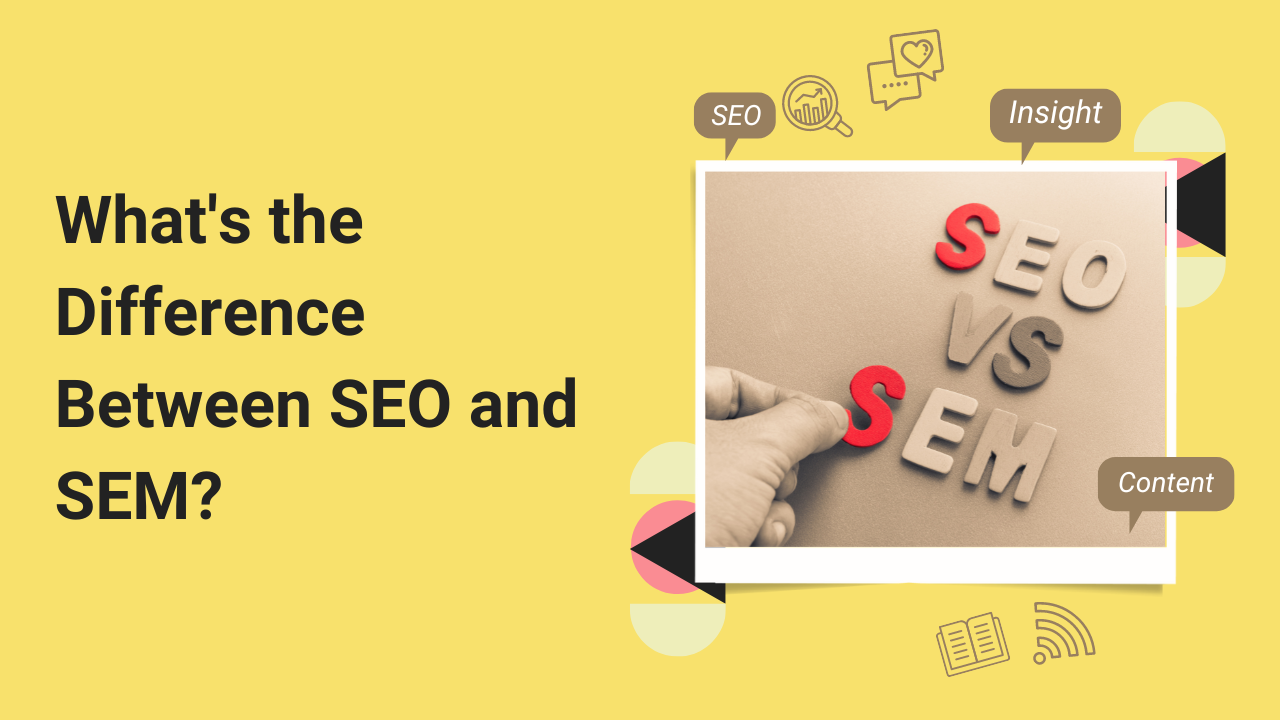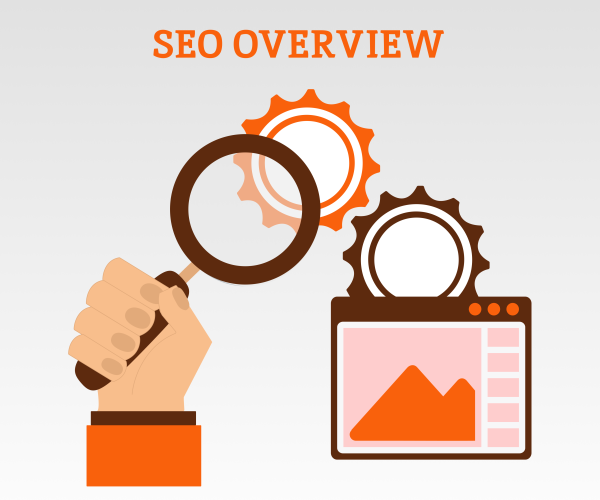
Table of Contents
SEO and SEM are strategies to boost website visibility in search engine results. SEO-optimized content and structure for organic ranking, while SEM includes paid advertising. Both increase website traffic and improve online presence.
SEM uses paid ads to boost website visibility and improve search result rankings. It involves bidding on keywords, crafting captivating ads, and managing campaigns.
In contrast, SEO focuses on organic growth, while SEM provides instant visibility through paid promotions.
In another way,
Regarding Google’s search results, they are categorized into two main sections: paid search results and organic search results. The main objective of search engine optimization (SEO) is to secure a prominent position in organic search results. Alternatively, you can feature your website in the paid section of search results through pay-per-click (PPC) advertising.
SEO is solely focused on optimizing your website to rank well in the organic search results. However, search engine marketing (SEM) is a more comprehensive approach combining SEO and PPC techniques to generate traffic from search engines. In other words, SEM is a broader concept encompassing both SEO and PPC, with SEO falling within the larger framework of SEM.
SEO VS SEM: Main Features
SEO Overview:

SEO involves optimizing a website to achieve higher rankings in the unpaid, organic search results pages (SERPs). Google’s algorithm considers over 200 ranking signals, classifying SEO into four primary subcategories: on-page SEO, off-page SEO, technical SEO, and User Interaction Signals.
1. On-Page SEO:
This is where you optimize individual web pages to enhance their visibility and relevance in search engine results. On-page SEO involves refining elements such as meta tags, headings, content quality, keyword utilization, and internal linking to improve the overall structure and content of the page.
2. Off-Page SEO:
Off-page SEO involves obtaining trust and authority signals from other websites, primarily through acquiring high-quality backlinks. It is worth noting that Google considers other off-page signals, including E-A-T and social media sharing, to evaluate the credibility and influence of your site.
3. Technical SEO:
Here’s where you prioritize enabling search engines like Google to crawl successfully and index all the pages within your website. Technical SEO also involves optimizing page load speed and ensuring the correct configuration of your site’s architecture.
4. User Interaction Signals:
User Interaction Signals serve as vital indicators for Google to gauge the relevance of your webpage to a user’s search intent. When users engage with your site, Google analyzes various factors, including bounce rates, to understand if your page adequately addresses their query. Suppose Google deems your page as mismatched or unsatisfactory for a given keyword. In that case, it can impact your rankings, leading to a decrease in visibility or even a complete exclusion from the first page of search results.
SEM Overview
SEM serves as an umbrella term that encompasses both SEO and PPC. As mentioned before, you can consider all the aspects outlined for SEO within the context of SEM. However, SEM incorporates PPC, a specialized field with specific features, recommended techniques, and additional considerations.
By combining SEO and PPC under the SEM umbrella, marketers can leverage a broader range of strategies to maximize online visibility and drive targeted website traffic.
1. Bidding:
Bidding in the context of paid search advertising, whether through platforms like Google Ads or Bing Ads, involves competing for ad placement by offering a monetary amount for specific keywords. When you engage in Pay-Per-Click (PPC) advertising, you use an auction-style system to set a bid amount for a particular keyword.
When a user searches using that keyword, the search engine determines which ads to display based on various factors, including bid amounts.
If your bid is among the highest, your ad can appear prominently in the search results. In essence, bidding determines how much you’re willing to pay to have your advertisement shown when someone searches for a specific keyword.
When a user clicks on your ad, you are charged the exact amount you had set as your bid. This payment, known as cost per click (CPC), is the agreed-upon price you will pay for each click on your advertisement. In simpler terms, the CPC is the specific cost you incur whenever someone interacts with your ad by clicking on it.
2. Quality Score
Quality Score is a crucial metric used by Google Ads to evaluate how well your ads match users’ search queries. It considers click-through rate, landing page quality, and overall account performance. A higher Quality Score leads to discounted clicks and better ad placement. It’s essential to improve CTR, optimize landing pages, and maintain a strong account performance to increase your Quality Score.

3. Ad Copy:
Ad copy is the text you see in advertisements. Writing captivating ad copy is essential because it dramatically impacts how well your ads perform in pay-per-click (PPC) campaigns. When your ad copy is excellent, people click on it more often, resulting in a high click-through rate (CTR). A high CTR is beneficial because it leads to a good Quality Score.
On the other hand, If your ad copy doesn’t persuade people to click, your Quality Score drops. This leads to higher ad costs because the platform considers your ads less valuable. In short, unconvincing ad copy can make you pay more per click in your PPC campaign.
SEO vs SEM: When Can You Expect to See Results?
The speed factor distinguishes SEO from SEM.
One notable contrast between SEO and SEM is the time frame for achieving desired outcomes.
SEO, being a long-term strategy, necessitates considerable patience as it gradually builds organic visibility and improves search rankings. This is particularly evident when dealing with nascent websites that need substantial backlinks. Research indicates that a website typically takes around two years to secure a position on Google’s first page.
Furthermore, it’s noteworthy that you initially published many of the currently top-ranking pages more than three years ago.
Managing expectations regarding Google ranking is essential, as the process typically takes approximately two years. However, by adopting a strategic approach that involves targeting long-tail keywords and implementing effective SEO practices, individuals can begin to see notable improvements within a few months.
Comparing the Costs of SEO and SEM: Which One is More Affordable?
SEO and SEM (Search Engine Marketing) are essential strategies for driving traffic to a website, but they have different cost structures and considerations.
SEO may initially seem like a free way to gain website traffic, but it’s only partially accessible. Achieving high rankings in Google’s organic search results requires significant effort. Website owners need to create high-quality content and promote it through email outreach.
Additionally, proper keyword research often involves the use of paid SEO tools. Content writing can be time-consuming, often taking more than 10 hours to produce valuable material. Hiring a graphic designer for promotional materials might be necessary to enhance brand visibility.
On the other hand, SEM primarily relies on PPC (Pay-Per-Click) advertising. This means you pay upfront for each click on your ads. The advantage of SEM is that you can see immediate results if you’re willing to invest money. Automated bidding options can help ensure your ads appear in specific positions, providing some control.
In the short term, PPC can be more cost-effective than SEO since you’re directly paying for the traffic you receive. However, PPC has a downside: when you stop paying for ads, your traffic drops to zero.
Conversely, SEO requires an upfront investment of time and resources to create valuable content and optimize your website for search engines. But once you achieve high rankings, the traffic becomes more sustainable, and you don’t need to spend as much money maintaining your current position.
Therefore, many businesses opt for a marketing strategy combining SEO and PPC. This way, they can benefit from the immediate results of PPC while also working towards the long-term, sustainable traffic generated by SEO. It’s crucial to find the right balance between the two approaches to maximize the overall effectiveness of your marketing efforts.
You are choosing: SEO or PPC - What's Best for Your Marketing?
Is it advisable to allocate your entire digital marketing focus towards SEO, or would a more strategic approach involve amalgamating SEO and PPC tactics for a robust search marketing campaign?
When Prioritize SEO:
1. Your budget is minimal:
Startups or small businesses should emphasize SEO efforts when operating with a limited marketing budget. While the returns on SEO might take longer to materialize, it proves to be a wiser choice than depleting the budget on PPC ads with a limited duration.
2. Achieving high rankings for informational keywords is within your reach.
Search queries involving informational keywords, like “What is X” or “How to X,” may not lead to high conversions, but they generate substantial search traffic. If you believe you can produce exceptional content that aligns with what customers search for on Google, then SEO should be your preferred strategy.
3. Embrace Patience
Patience is vital when it comes to SEO and content marketing. If you can wait 6-12 months to witness substantial traffic from Google searches, then embracing SEO is the best choice.
4. Proficient in Link Building
Having excellent link-building skills is crucial for achieving a high Google ranking. While creating top-notch content is essential, it alone may not be sufficient. To significantly improve your order, you must employ various link-building strategies to encourage other websites to link to your content.
When to prioritize PPC:
1. Consistent Ad Budget:
PPC ads offer the convenience of setting a strict budget, preventing overspending beyond your intended limits. Nevertheless, beginners in paid advertising may find themselves quickly exhausting their budget as they navigate the intricacies of keyword targeting, ad copy, landing pages, and bidding strategies.
2. You are equipped to handle an AdWords account:
The concept of PPC seems deceptively simple – bidding on keywords to generate website traffic. Yet, managing a Google Ads account takes a lot of work. Delving into the intricacies of keyword targeting, ad formulation, assessing Quality Scores, analyzing ROI, and monitoring conversion rates all demand careful consideration. By adeptly handling this data, you can make informed decisions to maximize the impact of your ads.
3. Launch and test landing pages:
Among the initial lessons in PPC involves understanding the necessity of having specific landing pages aligned with each ad or ad group. To fully leverage the potential of PPC, it is imperative to have a rapid deployment system for various web pages. Furthermore, conducting A/B tests is vital in ascertaining which landing page variations perform exceptionally well.
When is the right time to implement both SEO and PPC campaigns?
Combining SEO (Search Engine Optimization) and PPC (Pay-Per-Click) advertising can be an effective strategy under certain circumstances. SEO and PPC are essential components of a comprehensive digital marketing approach and can complement each other to achieve optimal results.
Firstly, when launching a new website or business, PPC can provide immediate visibility and drive traffic, while SEO efforts take time to show substantial results. This ensures a quick online presence and enables the business to generate leads or sales from the outset.
Secondly, in highly competitive industries, where organic SEO rankings are challenging, You can use PPC to gain exposure to valuable keywords. Meanwhile, the SEO efforts continue in the background, working towards improving organic rankings in the long run.
Thirdly, during seasonal or time-sensitive campaigns, PPC allows you to quickly target specific keywords or audiences. At the same time, SEO may not achieve the desired results within the limited timeframe.
Fourthly, combining SEO and PPC allows for more extensive keyword research and data analysis. PPC campaigns can reveal valuable insights about which keywords and ad copy drive the most conversions, which can be used to optimize the SEO strategy.
However, it’s crucial to maintain a cohesive marketing approach by ensuring consistency in messaging, branding, and user experience across both channels. Regular monitoring, analysis, and adjustments are essential to maximize the overall return on investment (ROI) and make the most of the combined SEO and PPC efforts.
About the Author
My name’s Semil Shah, and I pride myself on being the last digital marketer that you’ll ever need. Having worked internationally across agile and disruptive teams from San Fransico to London, I can help you take what you are doing in digital to a whole next level.



